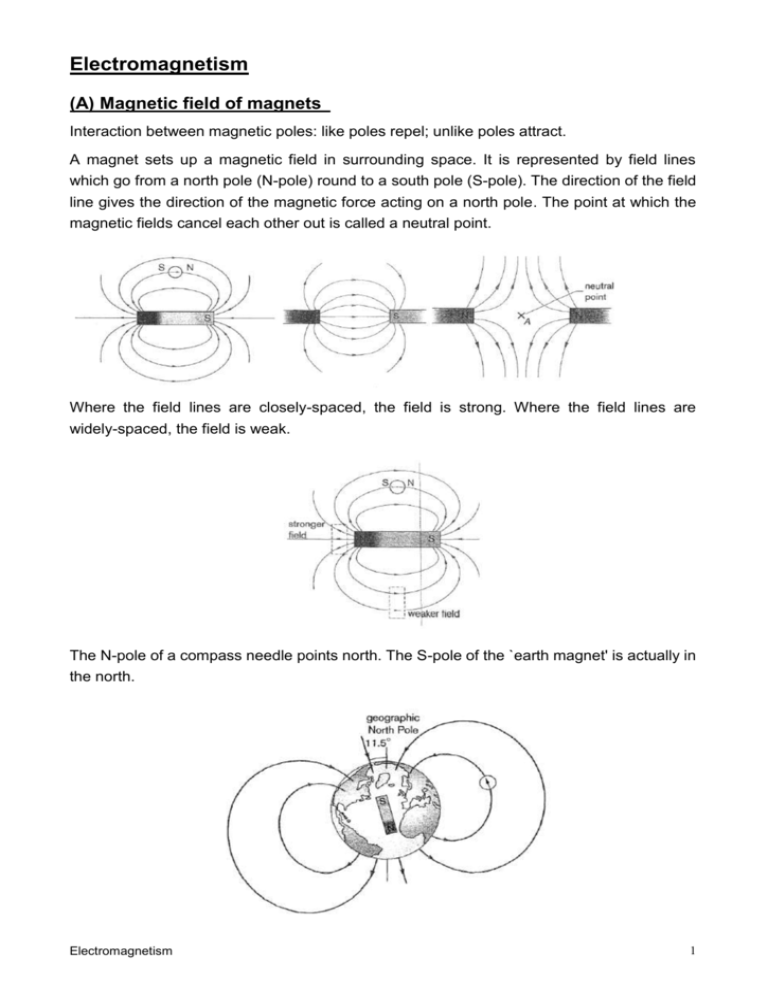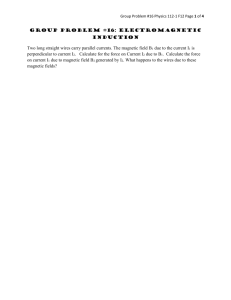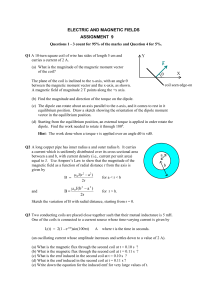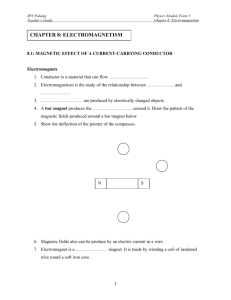Electromagnetism
advertisement

Electromagnetism (A) Magnetic field of magnets Interaction between magnetic poles: like poles repel; unlike poles attract. A magnet sets up a magnetic field in surrounding space. It is represented by field lines which go from a north pole (N-pole) round to a south pole (S-pole). The direction of the field line gives the direction of the magnetic force acting on a north pole. The point at which the magnetic fields cancel each other out is called a neutral point. Where the field lines are closely-spaced, the field is strong. Where the field lines are widely-spaced, the field is weak. The N-pole of a compass needle points north. The S-pole of the `earth magnet' is actually in the north. Electromagnetism 1 (B) Magnetic field of electric currents (1) Magnetic field around a current-carrying conductor Current sets up a magnetic field. The field lines around a wire are circular. Their direction can be worked out with the right-hand grip rule for straight wire. The field lines at the centre of a flat coil is straight and at right angles to the plane of the coil. Outside the coil, they run in loops. The magnetic field outside a solenoid is similar to that of a bar magnet. The poles of the solenoid can be worked out using the right-hand grip rule for solenoid. The magnetic field of the solenoid can be increased by increasing the current, increasing the number of turns in the solenoid (for the same length of solenoid), inserting a soft-iron core through the solenoid. (Note that the solenoid retains its magnetism even after the current has been switched off if the core is made of steel instead.) Electromagnetism 2 (2) Electromagnets An electromagnet consists of a coil of many turns of insulated copper wires. The coil is wound round a core made of a magnetic material, like soft-iron, to make the magnetic field stronger. An electromagnet can be made stronger by the following: increasing the current, increasing the number of turns in the solenoid, inserting a soft-iron core through the solenoid. Electromagnets are used in the following: (i) Electric bells and buzzers (ii) Telephones (iii) Maglev train Electromagnetism 3 (C) Force on electric currents in a magnetic field (1) Force on a current-carrying conductor A current-carrying conductor experiences a force when placed in a magnetic field. The directions of the force, the magnetic field and the current can be worked out using Fleming's left-hand rule. (2) Turning effect on a coil Current through a coil produces a turning effect on a coil. Greatest clockwise turning effect (for the same current and magnetic field strength) Clockwise (not the greatest) turning effect (for the same current and magnetic field strength) Anticlockwise (not the greatest) turning effect (for the same current and magnetic field strength) No turning effect Electromagnetism 4 (3) Applications (i) Moving-coil loudspeakers The following figure shows the structure of a moving-coil loudspeaker. As the alternating current flows backwards and forwards through the coil, the coil is pushed in and out. This makes the cone vibrate and give out sound waves (ii) Electric motors An electric motor contains a rectangular coil which is free to rotate between the pales of a magnet. Current flows into the coil via carbon brushes and a commutator (or split ring). The commutator is a device that reverses the current direction every time the coil makes a half-turn and thus enables the coil to rotate continuously. The carbon brushes are used to enhance contact. In a practical motor, the coil is made up of a large number of turns wound on a soft-iron core (armature) to increase the magnetic field strength. The coils are set at different angles and Electromagnetism 5 the pole pieces of the magnet are made curved to give a smoother running and a greater turning effect. Electromagnetism 6








